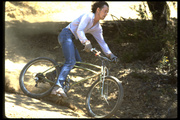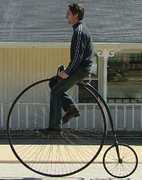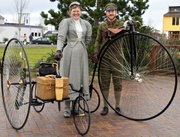
Jeffrey Conner doesn’t remember exactly how he acquired his first bicycle headbadge during a post-college gig as a bike mechanic in Seattle, but he does know it was an English-made, Rocket-brand badge someone had spray-painted blue. The metal tag had originally adorned the head tube on a bicycle frame, and like other headbadges, it was probably the only surviving part from an older bike that had been mistreated or left out in the elements to decay.
“Even small towns had their own bicycle manufacturers.”
Long after leaving the mechanic job, Conner hung onto the little Rocket talisman, toting it with him as he moved across the country and embarked on a career as an evolutionary biologist. Only decades later did Conner realize that bike badges were available in abundance on eBay, and his casual interest quickly blossomed into an obsession.
Today, Conner has more than 1,000 headbadges in his collection, which he meticulously documents and shares on his personal flickr as well as a group for fellow collectors with more than 800 members. In 2016, Conner’s collection also became the basis of a small book entitled A Cycling Lexicon, featuring photographs of the badges alphabetized by brand name. Originally produced by Carter Wong design, the book was later republished by Ginko Press.

Top: A badge for the Record Cycle Company, possibly from the Netherlands. Above: A sampling of the headbadges in Conner’s collection. Photo by Michael Blann for “Roleur.”
Though the headbadge’s debut is a bit murky, its heyday aligned with the bicycling boom of the late 19th century, when hundreds of new bike companies popped up across the developed world to satisfy demand for the so-called safety bicycle. “Around the late 19th and early 20th centuries, in Europe and the United States, even small towns had their own bicycle manufacturers,” Conner explains. “French and Belgian badges often had their town’s name on them, but small bike businesses were scattered all over the place.” As competition increased, headbadges were adopted to give brands a unique identity and build customer loyalty.
In 1898, due to problems with oversupply and competitive pricing in the American bike market, dozens of manufacturers joined together to form a giant trust called the American Bicycle Company (ABC). Although ABC failed a few years later, other successful companies like Pope, Schwinn, and Raleigh followed its lead and bought up hundreds of small bicycle brands. “There was a tremendous consolidation in the 20th century, similar to the car industry,” Conner says.

Conner’s first headbadge was this pressed-aluminum Rocket piece.
As mom-and-pop bike shops were absorbed into larger conglomerates, the branded headbadge became even more important, offering manufacturers a way to differentiate their bikes from each other and also to brand unique models within their own product lines. “For example,” Conner continues, “by the 1950s, Raleigh had taken over most of the British bike industry, buying up nearly everyone else. But they kept using the headbadges for companies that they bought—Rudge, Phillips, and so on. Raleigh still sold those bikes using their original brand badges, while Raleigh-branded bikes almost all used a version of its classic heron badge.”
Many bicycle badges tended to showcase imagery associated with power, speed, and technology—including wild animals, scenic vistas, and futuristic machines. “The French and Belgian badges were often the most ornate and artistic,” Conner says, “with lots of mythological characters and detailed imagery, whereas the Scandinavian and American badges used more graphic, cleaner designs. Themes like airplanes, rocket ships, and trains were used all over.”
Ranging from under an inch to almost half a foot long, headbadges were mostly made from pressed or acid-etched metals like brass, copper, aluminum, zinc, or stainless steel. “Brass and copper were very common in the early years, as well as chrome- or nickel-plating over brass,” Conner explains. “They were often painted, or enameled with cloisonné. By the 1950s, companies started switching to aluminum because it was cheaper, but many badges were still painted.”

A version of Raleigh’s heron badge, circa 1960s-’70s.
Traditional metal bike badges began disappearing in the 1970s with the advent of plastic decals. “Now, most manufacturers use a sticker or decal,” Conner says, “though a lot of the custom bicycle builders in the United States are making beautiful metal badges again. Rivendell is a pretty famous example. They make long-distance touring bikes out of steel and have different headbadges with great detail for every model.”
Of the many headbadges in his personal collection, Conner says he can’t choose a particular favorite because it’s like picking a favorite child—they’re all equally loved. However, he does recognize that some of the designs stick out more than others. “There’s an old one called Stormer, which has to be from the turn of the century or a little earlier, and I swear there are two places on the badge that show three sperm swimming toward an egg,” Conner says. “It’s like the sperm ‘storming’ the egg. The image is fairly subtle, but I can’t imagine it’s anything other than sperm and egg, and I’m a biologist so I know what I’m talking about here.”
Conner acknowledges that his collection has gotten so large, he sometimes can’t remember if he already owns a particular headbadge. “It’s a little silly,” he says. Yet nearly every time he searches, unfamiliar badges pop up that keep the collection growing, even if expansion isn’t his primary focus. “When I think about my goals, I think more about photographing and restoring,” Conner explains. “I know this is somewhat controversial in the antiques world, and my aim isn’t to get rid of all the patina, but if I can make a design clearer, then that’s what I want to do. They’re like little pieces of art, and that’s what art restorers do—try to make a painting or sculpture look the way the artist originally intended.”

Left, a brass Stormer badge from Westfield, Massachusetts, with its unique sperm-and-egg depiction. Right, a graphic Sole Mio headbadge from Nantes, France.
As a lifelong cyclist, Conner is also curious about the bicycle manufacturers behind these badges, though he’s found it is usually impossible to determine what happened to them. “Part of the problem is if I just have a brand name, sometimes they were used by multiple manufacturers—so there might have been somebody in upstate New York and someone in Cleveland naming their bikes the same thing,” Conner says. “College names like Harvard, Yale, or Princeton were very popular for badges, as were names referencing strength, so it’s hard to trace them. I don’t even know what country some of them are from.”
Even headbadges with detailed information can lead to dead ends, which sometimes have their own mysterious appeal. “I live near Kalamazoo, Michigan, and I have a badge from Kalamazoo that has an address on it,” Conner explains. “So I went to the address and there’s nothing there now—it’s an empty lot. But the city’s new bike path goes right by it.”

A headbadge for the National Cycle Manufacturing Co. from Bay City, Michigan, circa 1900.
(For more of Jeffrey Conner’s headbadges, check out the book, “A Cycling Lexicon,” or his flickr page. Except where noted, all photos courtesy Jeffrey Conner and Ginko Press.) If you buy something through a link in this article, Collectors Weekly may get a share of the sale. Learn more.






























 American Picker Dream, Part I: Mike Wolfe On His Love Affair With Bikes
American Picker Dream, Part I: Mike Wolfe On His Love Affair With Bikes
 The Hippie Daredevils Who Were Just Crazy Enough to Invent Mountain Biking
The Hippie Daredevils Who Were Just Crazy Enough to Invent Mountain Biking American Picker Dream, Part I: Mike Wolfe On His Love Affair With Bikes
American Picker Dream, Part I: Mike Wolfe On His Love Affair With Bikes Dissecting the Dream of the 1890s: My Skype Date With Those Curious Neo-Victorians
Dissecting the Dream of the 1890s: My Skype Date With Those Curious Neo-Victorians BicyclesThe precursor to the modern-day bicycle was the 1817 Draisine, named for it…
BicyclesThe precursor to the modern-day bicycle was the 1817 Draisine, named for it… Mari Tepper: Laying it on the Line
Mari Tepper: Laying it on the Line Nice Ice: Valerie Hammond on the Genteel Charm of Vintage Canadian Costume Jewelry
Nice Ice: Valerie Hammond on the Genteel Charm of Vintage Canadian Costume Jewelry How Jim Heimann Got Crazy for California Architecture
How Jim Heimann Got Crazy for California Architecture Modernist Man: Jock Peters May Be the Most Influential Architect You've Never Heard Of
Modernist Man: Jock Peters May Be the Most Influential Architect You've Never Heard Of Meet Cute: Were Kokeshi Dolls the Models for Hello Kitty, Pokemon, and Be@rbrick?
Meet Cute: Were Kokeshi Dolls the Models for Hello Kitty, Pokemon, and Be@rbrick? When the King of Comedy Posters Set His Surreal Sights on the World of Rock 'n' Roll
When the King of Comedy Posters Set His Surreal Sights on the World of Rock 'n' Roll How One Artist Makes New Art From Old Coloring Books and Found Photos
How One Artist Makes New Art From Old Coloring Books and Found Photos Say Cheese! How Bad Photography Has Changed Our Definition of Good Pictures
Say Cheese! How Bad Photography Has Changed Our Definition of Good Pictures Middle Earthenware: One Family's Quest to Reclaim Its Place in British Pottery History
Middle Earthenware: One Family's Quest to Reclaim Its Place in British Pottery History Fancy Fowl: How an Evil Sea Captain and a Beloved Queen Made the World Crave KFC
Fancy Fowl: How an Evil Sea Captain and a Beloved Queen Made the World Crave KFC
If a bicycle is badged as Gergovia, that warrior is a Gaul, not a Viking. As our Asterix books tell us, the Gallic leader Vercingetorix led his forces to victory against Caesar’s Roman forces at Gergovia in 52BC.
A wonderful collecting focus highlighting an otherwise overlooked type of industrial art. Such diversity! Very interesting.
N°22 isn’t a Viking but a Gaul, probably Vercingétorix, who win a battle against Julius Caesar at Gergovia.
the invader is made by norman a english bike company norman invader
I am trying to locate and purchase a Norman englich bicycle badge. Do you where I can find one? I have looked on the internet and ebay. thank you
I like the book , there are nice pictures.
The only problem is that there is no information about factory and country where they where made . I would be nice if a list was published on the internet .
I own collection of 2750 head badges if there are other collectors inserted in headbadges there is a Facebook group withe te name .
Earley Bicycle headbadges transfers decals pin backs
As a lad, 65 years ago, I came across a frame in a scrap yard that had an Apis badge like the one you show. This is the only other I have seen and wonder if you have any further details, origin , etc.
Thank, Derek
Do you have pictures of the bikes to go along with the headband
hello I just found 2 Vic Brooks Sports Wheel head badges from Woodstock Ontario,, I live in Ontario.. What kind of value would they have in nice condition ? Matt
Im looking for a Bill Matthews bike co. head badge
is this something you might be able to help me with if so please let me know
Hi Jeffry
I accidentally found your pictures of the wheel head plates. Well amazing what a collection you have, really.
My name is Petr Lacko and I’m from the Czech Republic.
I’ve seen them on Pinterest before but didn’t know anyone collected them, so I’m glad I discovered you :)
It’s amazing how many small frame makers there used to be and when I imagine how much history, fates, successes and life stories are actually behind each label it makes me wonder and moreover if there are still today some continuators that’s amazing.
I was already interested a few years ago and I liked the original designs, how they managed to play with the details back then.
I was also a bike mechanic and bike salesman for a while and have actually been riding bikes all my life, plus competing in rowing, speed canoeing, triathlon, quadriathlon. Well now it’s just bikes and even though I started out on steel, then aluminum, I still have a Cannondale, and now carbon, I still like those steel bikes. And with today’s opportunities to get information, I’m amazed at who has what and what all was made and what you can get..
Jeffry I have a request to you, can I please use the pictures for myself and possibly for advertising ? I really like some of them :)
I would be glad for your kind reply
So far, my best regards.
Petr Lacko
Brno
Czech Republic
PS – I hope you don’t mind that I don’t speak English, sorry, Deepl is a great helper :)
Translated with DeepL.com (free version)
Hi Petr,
Thank you for your comment on our article. This is an interview conducted by one of our writers and like we mentioned in the article, we do not own the rights to any of the images featured. We suggest trying to contact Jeffrey directly on his Flickr page, you might have more luck there.
Best,
CW
How can I contact you?
Dear Stan,
Can you please let us know the reason why you would like to get in touch with us, so we can redirect you to the person who can best help you?
CW